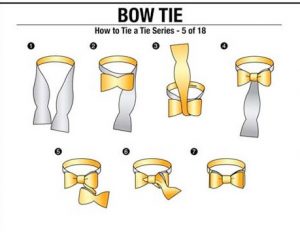15 ways to make a fancy Tie knot in your tie
Most men wear only one tie knot our entire lives. The same is because we are creatures of habit, maybe we are boring, or we just don’t like to experiment and try new things.
Most of us may tie the same tie knot because we don’t have an easy guide to show us how to experiment with other ways to tie it.
Here are 15 elegant knots and how to do them step by step so that you are encouraged to try them, either for work or even with more casual clothes.
The Four in Hand Tie Knot
The Cuatro en Mano is named after a 19th century Gentlemen’s Club of the same name and is clearly the champion among tie knots. Its popularity is due to its simplicity and versatility . It’s easy to tie, slim, slightly asymmetrical, and self-releasing. If you only learn one knot, let it be Four in Hand.
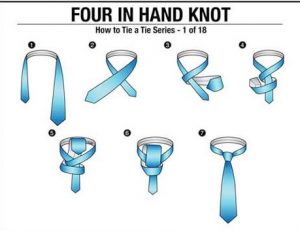
Middle Windsor Tie Knot
The Half Windsor knot is an extremely versatile knot. Contrary to its name, the Half Windsor knot is actually closer to three-quarters the size of the Windsor knot. It is medium in size, almost symmetrical and, when properly tied, produces a noticeable deep dimple. Best worn with medium to narrow thickness ties.
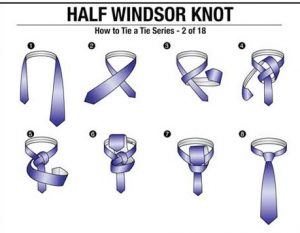
Windsor Tie Knot
The Duke of Windsor never specifically used the Windsor knot . In fact, the Duke achieved his innovative look by tying a Four in Hand with wide and thick ties specially made for him. This knot arose from the tie wearers themselves trying to imitate the style of the Duke’s knot. There are several derivatives of Windsor that use the same name. The Windsor offers a solid and symmetrical triangle knot that works best with a wide neck.

Simple / Oriental Tie Knot
The Simple knot contains as few steps as possible and is very easy to learn. Despite its simplicity, this knot is rarely used in the West, but it remains popular in China . This may be because it is more difficult to untie. It is a compact knot with an asymmetry that causes it to lean towards the active end. This knot works well with thick ties or for tall men who need a bit more length.
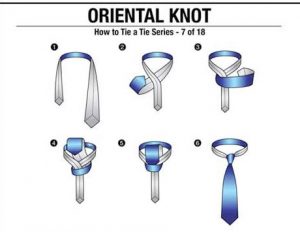
Kelvin Tie Knot
The Kelvin tie knot is named after Lord Kelvin (William Thomson, 1824-1907), a mathematical physicist who contributed to the theory of knots in relation to atomic structure. The Kelvin is an extension of the Simple knot . Like this one, the Kelvin starts with the tie found upside down, resulting in an inverted tail. This knot produces a neat and agile knot similar in size to Hand Fours but slightly larger and more angular.
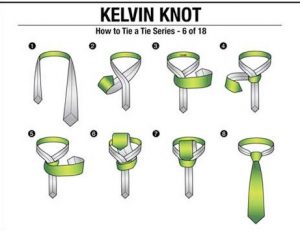
Pratt Tie Knot
Jerry Pratt worked for the US Chamber of Commerce For 30 years, Mr. Pratt had tied his tie in distinctive style before host Don Shelby “discovered” it and advertised it on local television in 1989. When articles about the ” Shelby Knot ” (as it was called then) appeared in the New York Times and the New York Daily Telegraph , the popularity of the knot skyrocketed. The Pratt knot is versatile , elegant and medium in size , between the Four in Hand Knot and the Middle Windsor Knot.
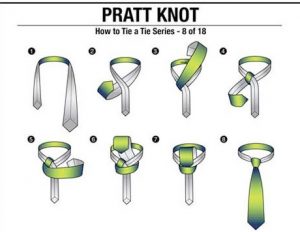
Balthus Tie Knot
This knot was invented around 1930 by Balthus (Baltasar Klossowski), a controversial Polish-French modern artist. The Balthus knot is large in size (significantly larger than the Windsor ). When executed correctly, the resulting knot is wide and tapered in shape . Note that due to the large number of times the wide end is wrapped around the small end, the finished tie will be very short.
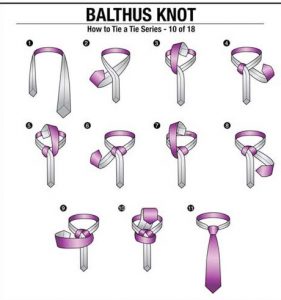
Victory Tie Knot
This knot is named after Queen Victoria of England (although it is highly unlikely that she used it herself). There is no apparent correlation between the style of the knot and the queen herself.
But the Victoria knot is (technically) a bulkier and more complex version of the Four in Hand . More exactly for a single extra pass up front. Some say that the name ” Victoria ” perhaps has something to do with the fact that it is a bit more sophisticated than the knot on which it is based.
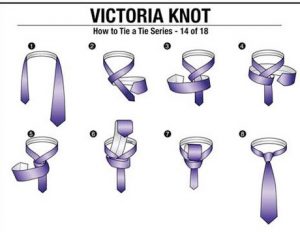
Nicky Tie Knot
The name ” Nicky ” supposedly comes from Nikita Khrushchev’s visit to Milan , where “inside-out” knots such as Nicky and Pratt knots are commonly used in shop windows and tailors. The Nicky has a particularly practical feature: to untie it, simply lift the narrow end to undo the knot.
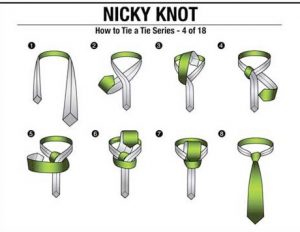
St. Andrew Tie Knot
It’s basically a medium- sized knot that suits most types of faces and looks. Although the design is asymmetrical , it really does appear almost symmetrical unless viewed up close.
It is classified as a narrow tie knot, but is slightly larger than those in the same category. That makes it a good option for men with rounder faces or wider shoulders, helping to provide the features. But the biggest advantage it has is that it is a very practical knot and also with some volume . You won’t waste a lot of time learning it.
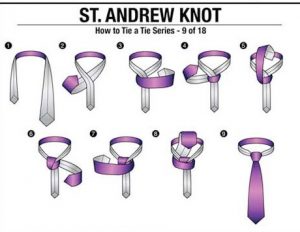
Hanover Tie Knot
The Hanover knot is large and symmetrical . It takes its name supposedly from the House of Hannover , the royal dynasty that ruled the UK from 1714 to 1901. But there is not much evidence that any monarch during that period actually used it. And since that period was mostly under the reign of Queen Victoria, this modern style of tie might not have been so popular back then. A properly made Hanover knot forms an equilateral triangle with a very distinctive symmetry .
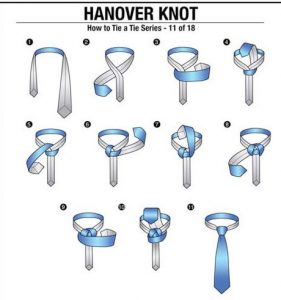
Coffee Tie Knot
As the name suggests, it was one of the favorite styles of coffee shoppers in the early part of the 20th century . It is an elegant and unnecessarily complicated knot , designed to draw attention to the skill of knotting (and, in general, to the fine silk tie). The final shape has a distinct pair of downward diagonals that frame the center of the triangular knot . It is not entirely symmetrical, as one “leg” of the triangle overlaps the other.
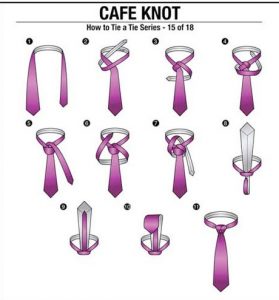
Eldredge Tie Knot
The Eldredge is an unorthodox , complex and eye-catching tie knot that involves 15 separate steps. It was invented by Jeffrey Eldredge in 2007 and rose to internet fame in 2008. Unlike the vast majority of tie knots, this knot is formed using the small end as the active end. When finished, the small remaining end is hidden behind the collar of the shirt. The knot is large (larger than the Windsor ) and creates a tapered fishtail braid effect.
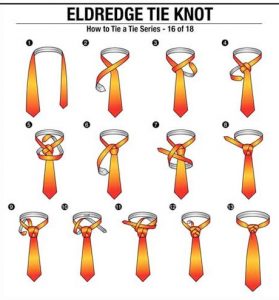
Trinity Tie Knot
The Trinity knot , like the Eldredge knot , is a relatively recent innovation. The finished knot shares similarity with the Celtic Triquetra . Tied using the small end as the active end, this knot is tied loosely and pulled tight at the end. The Trinity produces a rounded shape that is slightly asymmetrical , somewhat larger than the Windsor knot, and visually striking.

Bow tie Tie Knot
The bow tie is a descendant of the knotted tie. It was born out of the need to wear ties that are easier to wear and last all day intact. At the end of the 19th century , the butterfly and bat bow tie were commonly used. Black bow ties with dinner jacket and white bow ties with tails were used for maximum etiquette. Today, bow ties are mostly worn on formal occasions ; however, in the last decade, everyday bow ties have grown in popularity. A bow tie is perfect for any man who likes to stand out .
